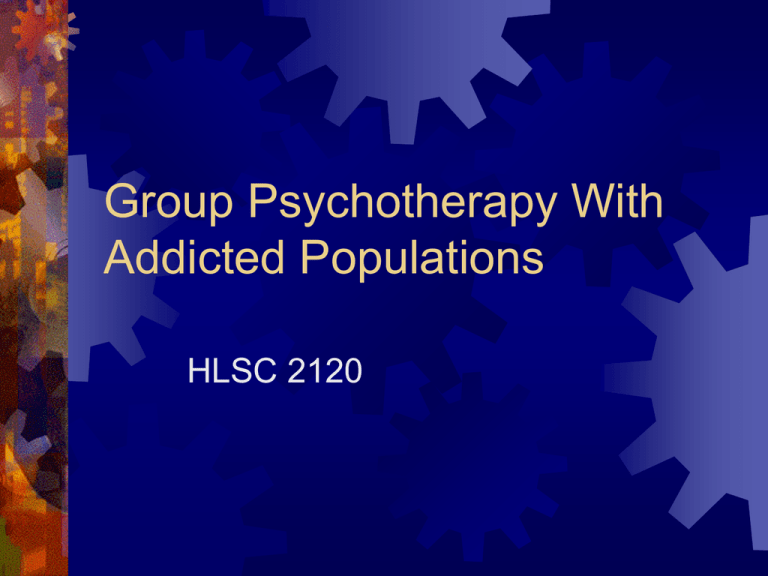Group Psychotherapy With Addicted Populations HLSC 2120
advertisement

Group Psychotherapy With Addicted Populations HLSC 2120 A well conducted group Flores states: A well-conducted group in conjunction with AA has a substantial impact on the treatment effectiveness with this population. Group Psychotherapy Modern group therapy is aimed at resolving impediments of its members by saying new things and establishing new relationships. 1) Bridging Melt barriers of isolation. It is believed that clients are more apt to respond to peer influence rather than to authoritative influence. Similarity bridging Reactive bridging 2) Focus on Immediacy A group in which resistances to immediacy are resolved is a group that brims with life. Flores 3) Establishing the Observing Ego The insightful one’s 4) Developing the Insulation Barrier The therapist has learned how to strengthen and thicken these insulation barriers so that these people can more successfully wall off what is noxious to their function and sense of self. 5) Accentuating Emotional Communication One of the most important technical operations is to keep the group on an emotional level. The Influence of the Disease Model Rather, it is seen as a primary condition that must first be arrested if any progress in treatment is to be achieved and abstinence from all chemicals must by the first goal of recovery. Disease concept However, the disease concept stands that view completely on its head. Depression, anxiety, and character pathology are now viewed as a symptoms-the result, not the cause-of addiction. Specific Implications of Group Therapy with Chemical Dependency …the nature of the addiction process itself, which either produces or exacerbates depression, anxiety, isolation, denial, shame, transient cognitive impairment, and character pathology. A disease of denial Addiction is, in fact, frequently cited as a disease of denial. Altering a defensive style …the advantages group psychotherapy provides by confronting and altering the addict’s and alcoholic's defensive style is a major theme. The power of peer influence “By the crowd, they have been broken, by the crowd they shall be healed.” Ettin (1998) Group Therapy Washton (1992) summarizes advantages of group therapy 1) Mutual identification with and acceptance from others going through similar problems. 2) Positive role modeling for abstinence and reality testing about chemical use is enhanced because the addicted person has the opportunity to better understand their own attitudes about addictions and their defenses against giving up chemicals by confronting similar attitudes and defenses in others. Group Therapy 3) Confrontation, immediate feedback and positive peer pressure for abstinence. 4) Affiliation, cohesiveness, social support while learning to identify and communicate feelings more directly. 5) Structures, discipline and limit setting while permitting experiential learning and exchange of factual information about recovery and drug use. 6) Instillation of hope, inspiration for the future and the pursuit of shared goals and ideas. Addiction viewed as a disease Accepting addiction as a disease means viewing this condition as a physiological illness with emotional, behavioral, and conditioned response components, not as a secondary sign or symptom of some underlying mental or emotional disorder. Disease concept Finally, the disease concept establishes addiction as the primary illness and not some underlying symptom that will be alleviated once the real problem is solved. Physiological effects …flexible thinking, fluid intelligence, and new learning, alcoholics and addicts consistently score in the brain-impaired range. Yet their verbal intelligence and old learning remains pretty much intact. Consequently, they will often appear unimpaired to the unsuspecting observer.









